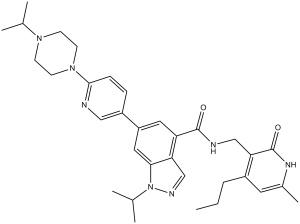UNC1999
This product is for research use only, not for human use. We do not sell to patients.

For small sizes, please check our retail website as below: www.invivochem.com
| Size | Price | Stock |
|---|---|---|
| 250mg | $820 | Check With Us |
| 500mg | $1390 | Check With Us |
| 1g | $2085 | Check With Us |
Cat #: V0385 CAS #: 1431612-23-5 Purity ≥ 98%
Description: UNC1999 (UNC-1999) is an orally bioavailable, cell-permeable, selective, SAM-competitive and dual inhibitor of EZH2/EZH1 (Enhancer of zeste homolog) with antineoplastic activity.
Top Publications Citing Invivochem Products
Publications Citing InvivoChem Products
Product Promise

- Physicochemical and Storage Information
- Protocol
- Related Biological Data
- Stock Solution Preparation
- Quality Control Documentation
| Molecular Weight (MW) | 569.74 |
|---|---|
| Molecular Formula | C33H43N7O2 |
| CAS No. | 1431612-23-5 |
| Storage | -20℃ for 3 years in powder formr |
| -80℃ for 2 years in solvent | |
| Solubility In Vitro | DMSO: 100 mg/mL (175.5 mM)r |
| Water: <1 mg/mLr | |
| Ethanol: <1 mg/mL | |
| SMILES Code | O=C(NCC1=C(CCC)C=C(C)NC1=O)C2=C3C(N(C(C)C)N=C3)=CC(C4=CC=C(N5CCN(C(C)C)CC5)N=C4)=C2 |
| Synonyms | UNC1999; UNC 1999; UNC-1999; |
| Protocol | In Vitro | UNC1999, the first orally bioavailable inhibitor that has high in vitro potency for wild-type and mutant EZH2 as well as EZH1, a closely related H3K27 methyltransferase that shares 96% sequence identity with EZH2 in their respective catalytic domains. UNC1999 is highly selective for EZH2 and EZH1 over a broad range of epigenetic and non-epigenetic targets, competitive with the cofactor SAM, and non-competitive with the peptide substrate. UNC1999 has Ki values of 4,700 nM, 65 nM, 300 nM, and 1,500 nM for sigma1, sigma2, histamine H3, and NET, respectively. NC1999 selectively kills DB cells, a DLBCL cell line with the EZH2 Y641N mutation. UNC1999 displays a concentration- and time-dependent inhibition of DB cell proliferation (EC50=633±101 nM (n=3)). |
|---|---|---|
| In Vivo | A single intraperitoneal (IP) injection of UNC1999 at 15, 50, or 150 mg/kg achieved high Cmax (9,700-11,800 nM) and exhibited dose linearity in male Swiss albino mice. Both the 150 and 50 mg/kg IP doses resulted in the plasma concentrations of UNC1999 above its cellular IC50 over the entire 24 h period while the 15 mg/kg IP dose led to the plasma concentrations of UNC1999 above its cellular IC50 for approximately 12 h. We next examined whether UNC1999 is orally bioavailable and are pleased to find that a single 50 mg/kg oral dose of UNC1999 achieved high Cmax (4,700 nM) and good exposure levels in male Swiss albino mice. The plasma concentrations of UNC1999 are maintained above its cellular IC50 for approximately 20 h following this single oral dose. It is worth noting that all doses including the 150 mg/kg IP dose are well tolerated by all test mice, and no adverse effects are observed. |
These protocols are for reference only. InvivoChem does not
independently validate these methods.
| Solvent volume to be added | Mass (the weight of a compound) | |||
|---|---|---|---|---|
| Mother liquor concentration | 1mg | 5mg | 10mg | 20mg |
| 1mM | 1.7552 mL | 8.7759 mL | 17.5519 mL | 35.1037 mL |
| 5mM | 0.3510 mL | 1.7552 mL | 3.5104 mL | 7.0207 mL |
| 10mM | 0.1755 mL | 0.8776 mL | 1.7552 mL | 3.5104 mL |
| 20mM | 0.0878 mL | 0.4388 mL | 0.8776 mL | 1.7552 mL |
The molarity calculator equation
Mass(g) = Concentration(mol/L) × Volume(L) × Molecular Weight(g/mol)
Mass
=
Concentration
×
Volume
×
Molecular Weight*
The dilution calculator equation
Concentration(start)
×
Volume(start)
=
Concentration(final)
×
Volume(final)
This equation is commonly abbreviated as: C1 V1 = C2 V2
Concentration(start)
C1
×
Volume(start)
V1
=
Concentration(final)
C2
×
Volume(final)
V2
Step One: Enter information below
Dosage mg/kg
Average weight of animals g
Dosing volume per animal µL
Number of animals
Step Two: Enter the in vivo formulation
%DMSO
+
%
+
%Tween 80
+
%ddH2O
Calculation Results:
Working concentration:
mg/ml;
Method for preparing DMSO master liquid:
mg
drug pre-dissolved in
µL
DMSO(Master liquid concentration
mg/mL)
,Please contact us first if the concentration exceeds the DMSO solubility of the batch of drug.
Method for preparing in vivo formulation:
Take
µL
DMSO master liquid, next add
µL
PEG300, mix and clarify, next add
µL
Tween 80,mix and clarify, next add
µL
ddH2O,mix and clarify.
Note:
- (1) Please be sure that the solution is clear before the addition of next solvent. Dissolution methods like vortex, ultrasound or warming and heat may be used to aid dissolving.
- (2) Be sure to add the solvent(s) in order.




































